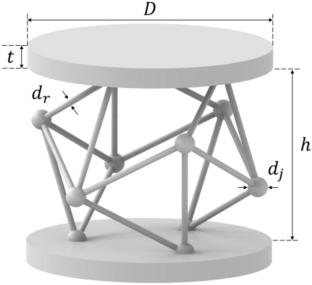A novel 3D-printable tensegrity-inspired metamaterial enabling dynamic attenuation
Abstract
Dynamic attenuation is a major concern in many engineering fields, and excessive energy inputs may cause fatal damages to the key devices. Therefore, there is always a demand to pursue a novel structure with the energy attenuation capacity. A metamaterial with periodic lattice-disc unit cells inspired by the tensegrity topological configuration is proposed in this study. Both theoretical and numerical modeling are conducted to examine the effects of geometrical dimensions on the bandgaps. Two types of chains are compared, including monoatomic and diatomic ones. With the increase of the number of unit cells, the dynamic attenuation effect of the bandgaps becomes prominent. This tensegrity-inspired metamaterial is 3D-printable by additive manufacturing technology. Both frequency sweep experiment and low-speed impact test are conducted. The torsional vibration mode is identified, which is decoupled with the axial vibration mode. Both improved spring-mass model and finite element model to describe the dual modes are developed to match well with the experiments. The behaviors of metamaterial bandgaps are fully verified by both numerical simulation and experiments. This study provides a novel idea for the design of additively-manufactured metamaterials for energy dissipation.


 求助内容:
求助内容: 应助结果提醒方式:
应助结果提醒方式:


